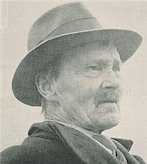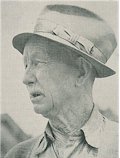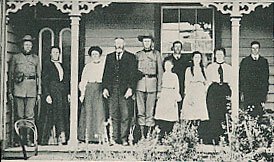Stokes Valley History
We continue with the seventh in our series of
short articles on the history of Stokes Valley. This month we get to know a little about
some of Stokes Valley's earliest residents and families.
Appreciation and thanks is extended to Poppy Watts
from whose book Stokes Valley Through the Years this information has been lifted
with only slight modifications. If you would like to purchase either or both of Poppy's
books, please e-mail editor@svn.co.nz for details as
to how you may do so:
Stokes Valley Through the Years [1953] by
Milton and Poppy Watts $10.00
This Was Speldhurst (The Story of an Early Stokes Valley Family) [2001] by Poppy
Watts $16.00
Early Residents (Part 1)
 Mr Thomas Mitchell came
with his parents, his brother George, and his sister Grace to Stokes Valley in August
1897. His parents' property was at the mouth of the Valley and the three children
completed their education at the Stokes Valley School. The family was engaged in dairy
farming and conducted a milk round in Lower Hutt as Mitchell Bros, Taita. After the death
of his parents, Thomas Mitchell continued to work the farm.
Mr Thomas Mitchell came
with his parents, his brother George, and his sister Grace to Stokes Valley in August
1897. His parents' property was at the mouth of the Valley and the three children
completed their education at the Stokes Valley School. The family was engaged in dairy
farming and conducted a milk round in Lower Hutt as Mitchell Bros, Taita. After the death
of his parents, Thomas Mitchell continued to work the farm.
Thomas Mitchell's grandfather, William Mitchell, arrived at Port Nicholson with his
parents and brothers in the ship The Gertrude in 1841. William and his brother
James were well-known in the early days as the proprietors of brickworks in upper Willis
Street. At one time William built and was licensee for 10 years of the Royal Tiger Hotel
in Taranaki Street. From that time on he was known as "Tiger" Mitchell.
William Mitchell's son George was born in Abel Smith Street. As a young man he went to
Australia where he married and began raising his children. He returned to Stokes Valley
with his family in 1897. In the later years of his life, George spent most of his days
sitting on an old log log at the corner of his section where he had a view of the traffic
travelling to and from Upper Hutt. The old gentleman received most of his entertainment by
engaging in conversation with drovers or horsemen who were willing to stop for a yarn. He
became quite a landmark - a signpost to Stokes Valley, as it were.
 Mr Thomas Delaney
is probably one of the better-known historical personalities of Stokes Valley. It is from
this man that Delaney park gets its name. Thomas Delaney's father came to new Zealand with
the 57th regiment at the commencement of the Maori Wars. He met a girl from his home
country (Ireland) and married, making his home in Wellington. Later, Mr Delaney Snr was
the licensee of the Waterloo Hotel, Kaiwharra, and it was here that Thomas Delaney was
born on May 24, 1871.
Mr Thomas Delaney
is probably one of the better-known historical personalities of Stokes Valley. It is from
this man that Delaney park gets its name. Thomas Delaney's father came to new Zealand with
the 57th regiment at the commencement of the Maori Wars. He met a girl from his home
country (Ireland) and married, making his home in Wellington. Later, Mr Delaney Snr was
the licensee of the Waterloo Hotel, Kaiwharra, and it was here that Thomas Delaney was
born on May 24, 1871.
In 1891 Thomas married Louise Archer and the
couple settled in Brooklyn, Wellington, where he took a great interest in public affairs,
including 14 years as a member of the School Committee. In 1907 he brought his wife and
family to Stokes Valley. He acted in the School Committee here for 16 years also, being
the secretary for the majority of that time. Other activities included chairing the Fire
Brigade Committee, being a member of the Progressive Association Committee, being
superintendent of the erection of the Koroanui Hall, assisting in the building of the
Presbyterian Church and in the construction of the swimming pool.
Thomas Delaney had a keen sense of humour and, in
his quite way, was able to tell quite a number of humorous stories about the early days,
one of which can be re-told here:
His neighbour, Mr Thorpe, anxious to whitewash his
fowlhouse, and not being in possession of any lime, asked Mr Delaney to lend him a bag
until he was able to procure some for himself. Mr Delaney was quite willing and even
offered to deliver it. The next day, the lime loaded on a barrow, he set of for his
neighbour's. Alas, however, the barrow had developed an abominable squeak. As Mr Delaney
approached the farm to this wretched accompaniment, Mr Thorpe's pet cow raised her head in
alarm, took one look at the squeaking barrow bearing down on her, lowered her head, raised
the turf with a mighty upthrust of hooves and lit out in the opposite direction as if
pursued by a hundred devils. Directly in her path lay Mr Thorpe's fowl runs, and even if
the terrified animal had noticed them, it is doubtful she could have reduced speed in time
to avoid them. As it was, she charged madly into the middle of drooping and insecurely
fastened netting, uprooting all, and careered down the paddock with the lot impaled on her
horns. In her path was left a flurry of feathers as the terrified, squawking poultry took
to the air. Her progress now somewhat impaired, she slithered to a trembling standstill,
her usually soft eyes dilated in terror and her whole frame enveloped in a tangle of
twisted netting. Mr Delaney took the wisest course, unloaded the lime and returned home to
oil the wheelbarrow.
Shortly, Mr Thorpe came panicking to Mr Delaney's
back door. his dear old cow had gone mad. Could Mr Delaney come quickly and see what could
be done? Mr Delaney was all sympathy, of course, and one could visualise the twinkle in
his Irish eyes as he set about the task of extricating the unfortunate beast and pacifying
Mr Thorpe.
The Russell Story
Born in 1815 in Kent, Edward Russell arrived in New Zealand on the New Zealand Company's
immigrant ship Lord William Bentinck, accompanied by his brother John in 1841. On
the ship Edward met Sarah Taverner whom he later married. They occupied a block of land in
Taita and in 1863 the brothers took over Section 74 in Stokes Valley which had originally
been granted to Robert henry Wood. There they built a house of their own and had six
children, Edward, Charles, James, Mary Ann, Martha and Helen.
 |
| Mr and Mrs Charles
Russell and their children at the family home in 1908. From left: Edgar, Mrs Russell,
Mildred, Mr Russell, Hugh, Lillian, Harold, Ida, May and Cecil. |
Later, John Russell's sons, James and John,
purchased properties from Manuka Road to Kairimu Road, building separate homes and farming
the land. Charles, born in 1859, married Mrs Charlotte Clement, daughter of John Clement,
a prominent person in the history of Methodism in Stokes Valley (to be covered later). The
wedding took place at Christ Church, Taita. Another home was built on the property for
Edward Russell, and Charles took his bride to the old homestead.
Edward Russell died on 18 December 1894, at the
age of 79. He was buried at St James Church, Lower Hutt.
Charles and Charlotte Russell had eight children,
all of whom were born in Stokes Valley, the sons assisting their father on the farm. Each
year the boys would be sent to clear the hillsides of young Manuka plants, pulling each
one out by hand. By this means the hillsides were kept clear and the property was able to
run a considerable number of sheep and cows, the Russells possessing a fine herd of
Holsteins. Vegetables and grapes were also grown most successfully. Charles Russell sold
his farm to Dr P Knight in 1910 and returned to Taita. he died in 1922 and was buried in
the Taita Cemetery.
William Judd Senr
Arriving at Port Nicholson on the Martha
Ridgway in July 1840, with his wife Anne and their sons John, George and Stephen,
William Judd lived for a time at Lower Hutt where his fourth son James was born.
Securing the contract to form a road through the
Taita Gorge, Mr Judd settled with his family at the entrance to Stokes Valley, later
constructing a home on a leasehold on the southern side of the present Stokes Valley Road.
This house, when not quite completed, was severely damaged in the earthquake of 23
February 1855. It was here that the last three members of the family were born.
In 1870 the Judds moved across the river to
Haywards and took up farming there. James was married in 1869 to Elizabeth Ralph who was
only 17 years of age, and at Haywards their first child was born, the first of 12. It was
for James Judd that the lovely old home known as Manor House was built by Mr Meager of
Taita in 1887, at a cost of £390. Early members of the Judd family are buried at Christ
Church, Taita.
 Mr Thomas Mitchell came
with his parents, his brother George, and his sister Grace to Stokes Valley in August
1897. His parents' property was at the mouth of the Valley and the three children
completed their education at the Stokes Valley School. The family was engaged in dairy
farming and conducted a milk round in Lower Hutt as Mitchell Bros, Taita. After the death
of his parents, Thomas Mitchell continued to work the farm.
Mr Thomas Mitchell came
with his parents, his brother George, and his sister Grace to Stokes Valley in August
1897. His parents' property was at the mouth of the Valley and the three children
completed their education at the Stokes Valley School. The family was engaged in dairy
farming and conducted a milk round in Lower Hutt as Mitchell Bros, Taita. After the death
of his parents, Thomas Mitchell continued to work the farm. Mr Thomas Delaney
is probably one of the better-known historical personalities of Stokes Valley. It is from
this man that Delaney park gets its name. Thomas Delaney's father came to new Zealand with
the 57th regiment at the commencement of the Maori Wars. He met a girl from his home
country (Ireland) and married, making his home in Wellington. Later, Mr Delaney Snr was
the licensee of the Waterloo Hotel, Kaiwharra, and it was here that Thomas Delaney was
born on May 24, 1871.
Mr Thomas Delaney
is probably one of the better-known historical personalities of Stokes Valley. It is from
this man that Delaney park gets its name. Thomas Delaney's father came to new Zealand with
the 57th regiment at the commencement of the Maori Wars. He met a girl from his home
country (Ireland) and married, making his home in Wellington. Later, Mr Delaney Snr was
the licensee of the Waterloo Hotel, Kaiwharra, and it was here that Thomas Delaney was
born on May 24, 1871. 